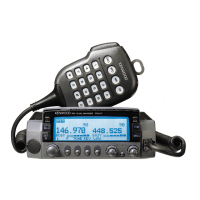
 Loading...
Loading...
Do you have a question about the Kenwood TM-V7A and is the answer not in the manual?
| VHF frequency range | 144~148MHz |
|---|---|
| UHF frequency range | 438~450MHz (U.S.A/Canada) |
| Antenna impedance | 50Ω |
| Usable temperature range | -20°C to +60°C (-4°F to +140°F) |
| Power supply | 13.8V DC ±15% (11.7~15.8V) |
| Grounding method | Negative-ground |
| Frequency stability | ±3ppm (-10°C to +50°C) |
| Dimensions (W x H x D) | 140 x 54.5 x 205.5 mm |
| High power output | 50W (VHF) / 35W (UHF) |
|---|---|
| Mid power output | Approx. 10W |
| Low power output | Approx. 5W |
| Spurious emissions | -60dB or less |
| Maximum frequency deviation | ±5kHz |
| Audio distortion | 3% or less (at 60% modulation) |
| Microphone impedance | 600Ω |
| Circuitry | Double conversion |
|---|---|
| Intermediate frequency (1st / 2nd) | 38.85MHz / 450kHz and 45.05MHz / 455kHz |
| Sensitivity (VHF or UHF band) | 0.16μV or less (12dB SINAD) |
| Sensitivity (Sub VHF or UHF band) | 0.25μV or less |
| Selectivity (-6dB) | 12kHz or more |
| Selectivity (-60dB) | 28kHz or less |
| Squelch sensitivity | 0.1μV or less |
| Audio output | 2W or higher (8 ohms, 5% distortion) |
| Audio output impedance | 8Ω |
| Weight | 1.2 kg (2.6 lb) |
|---|---|
| Dimensions (W x H x D) | 5.51" x 2.15" x 8.09" |